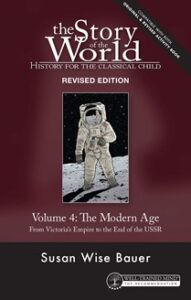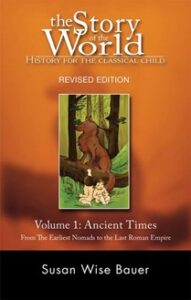Susan Wise Bauer’s The Story of the World: History for the Classical Child aims to provide elementary school children and older readers with a history of humanity in such regions of the world as Africa, China, Europe, and the Americas from antiquity to the present. The author seeks to familiarize readers with a broad swath of human history, utilizing language that is understandable for a wide range of ages, and organizing her writing in chronological fashion. Despite these positive features of her work, Volume 4: The Modern Age and Volume 1: Ancient Times contain significant errors.
These errors include erroneous claims about Jewish inhabitation, drawing inappropriate analogies that obscure historical data, and omissions of crucial information surrounding Israel’s establishment.
Volume 4: The Modern Age
Bauer erroneously implies that a collective Jewish presence in the land ended in 70 CE.
In “Chapter 30: Partitioned Countries,” Bauer claims that “[t]he Jewish people had not lived all together in Israel since the year AD 70 (or 70 CE), when the Romans drove the Jewish people out of Jerusalem and out of their country.”[1] In fact, “Even after the destruction of the Second Temple in Jerusalem, and the beginning of the exile, Jewish life in the land of Israel continued and often flourished.”[2]
Bauer later asserts, “For the last thousand years, Arabs had been living in Palestine,”[3] obscuring the fact that Jews also lived in the Land of Israel during this period of time.
Bauer erroneously suggests that the land belonged to Palestinians.
These inaccurate ideas relating to a supposed lack of Jewish presence in the Land of Israel provide the basis for the flawed analogy Bauer provides:
Imagine that, when your mother was a child, she grew up in the house you live in now. Her grandmother grew up there. So did her great-grandmother, and her great-great-grandmother, all the way back for a thousand years. Then, one day, a family you never met knocks on your door and says, “We lived in this house two thousand years ago, and it was taken away from us. So, we’d like to move back in now.”
How would you feel? Of course[,] it was wrong for the family to lose their house two thousand years ago. But, after all, it has been yours for as long as anyone can remember. You’d probably be surprised, confused, saddened, and outraged—like the Palestinian Arabs felt when the UN announced that the Jews could have part of Palestine back again.[4]
This analogy falsely suggests Jews ceased to reside in the Land of Israel two thousand years ago, and it also falsely suggests the land belonged to Palestinian Arabs at the time, which it did not. In fact, most of the land did not at any point belong to Palestinian Arabs. Furthermore, even at the time of the UN partition plan to which Bauer refers, the term “Palestinian” had not been customarily associated with Arabs, but rather was principally applied to Jews living in the land.
Later, Bauer reiterates the false claim about the land allegedly belonging to Palestinian Arabs when she states that “the Palestinian Arabs […] had been forced to leave their homes in Palestine when their land was claimed by Israel”[5] notwithstanding the fact that, again, the land did not belong to Palestinian Arabs, and many Palestinian Arabs chose to leave the land of their own volition rather than as the result of being expelled from the territory.
Bauer fails to acknowledge Jews’ strong ties to the Land of Israel.
Bauer suggests that Jews advocated for Zionism because they wondered: “Why should Jews live scattered all over the world—a few in Russia, a few in Germany, a few in England, a few in America? There should be one land where all the Jews could come and live.”[6]
This characterization of Zionist motivation fails to acknowledge the strong historical, religious, and cultural connections to the Land of Israel Jews have continuously maintained over millennia as well as the antisemitic persecution Jews often faced in diaspora communities even prior to the Shoah that render Jewish attempts to restore their sovereignty, autonomy, and ability to defend themselves in the Land of Israel more intelligible.
The text fails to establish that Arabs precipitated an attack on Israel in 1948.
In describing Israel’s War of Independence, Bauer notes, “Fighting between Jews and Arabs broke out almost at once [following Israel’s declaration of independence].”[7] Such a description suggests both sides were responsible for the war when, in fact, Arab countries chose to wage war on the nascent State of Israel.
Furthermore, the author erroneously claims, “In 1949, the attacking countries (except for Iraq, which refused) agreed to sign peace agreements with Israel.”[8] In fact, no such peace agreements were ever signed by Arab countries in 1949 notwithstanding the fact that the State of Israel sought to make peace with its neighbors.
The author makes other false claims without providing any substantiation for them.
Thus, Bauer asserts,
After the Six-Day War, when Israel took land away from three other Arab nations, the PLO realized that Israel would never give up any land to form a country for Palestinian Arabs. Israel seemed much more likely to claim as much land as possible, and to keep it for Israelis.[9]
Bauer, here, suggests that Israel’s taking of Jerusalem somehow constitutes acquisition of Jordanian land when it would be more accurate to describe Israel’s acquisition of this territory in a defensive war as constituting a reclamation, especially given the longstanding centrality of Jerusalem for Jews.
Moreover, Bauer’s inappropriate description of the PLO as having “realized,” rather than “thought” or “claimed,” that Israel would never give up any land to form a country for Palestinian Arabs falsely suggests this view was reality when, in fact, the Israeli government has repeatedly sought to make peace with and has evidenced a willingness to give land to Arabs (e.g., Sinai to Egypt in 1979 and Gaza to Palestinians in 2005).
Volume 1: Ancient Times
In “Chapter Thirty-Eight: The End of the Ancient Jewish Nation,” Bauer erroneously claims that “[t]he Jews didn’t return to the land of Canaan until just a few years ago.”[10] Bauer applies a pre-Israelite appellation to the territory that had long since been renamed Judea/Israel, and furthermore, Jews continued living in the land for many years following the Temple’s destruction. 
The text fails to provide the full context of Jewish resistance to Roman rule.
Bauer suggests that Jews chose to resist Roman rule simply because Romans coerced Jews into “pay[ing] high taxes,”[11] which oversimplifies factors contributing to Jewish resistance to Rome. While economic factors seem to have played a role in precipitating such resistance, other religious factors might have contributed.
A more complete explanation describes how “some Jewish uprisings […] might have been fueled by the belief that the end-time had arrived or was soon to do so, that G[-]d and his angels were about to enter the fray against the enemy and reestablish divine rule over the earth.”[12]
Some scholars conjecture that it is possible the Bar Kochba Revolt “might have been triggered by an imperial decree against circumcision or perhaps a ban against castration, conflated with circumcision.”[13]
Other scholars argue that this revolt “was a reaction against an attempt by Emperor Hadrian to turn Jerusalem into a pagan city with the name Aelia Capitolina,” thereby “associat[ing] the city with a pagan god” or “even possibl[y] […] dedicat[ing] [a temple] to Jupiter on the site of the [Jewish] Temple.”[14]
Conclusion
The desire to make human history more widely available and intelligible to readers young and old is an admirable objective. Based on the above analysis, though, it is evident that Bauer in The Story of the World: History for the Classical Child falls short in achieving this worthy goal in her treatment of the Jewish people. Bauer
- makes erroneous claims about an alleged absence of Jews from the Land of Israel that are reinforced through the drawing of inaccurate analogies,
- speaks of the signing of peace agreements with Israel in 1949 despite the fact that no such peace agreements were signed that year,
- inappropriately suggests Jews and Arabs were equally culpable of certain military conflicts,
- and oversimplifies the causes for Jewish revolt against Rome.
In these ways, Bauer has failed to provide her readers with a complete and accurate account of Jews and the State of Israel.
[1] Susan Wise Bauer, The Story of the World: History for the Classical Child: Volume 4: From Victoria’s Empire to the End of the USSR, Well-Trained Mind Press, 2021, p. 395
[2] Mitchell G. Bard, Myths and Facts: A Guide to the Arab-Israeli Conflict, American-Israeli Cooperative Enterprise, 2017, p. 1
[3] Bauer, The Story of the World: History for the Classical Child: Volume 4: From Victoria’s Empire to the End of the USSR, p. 398
[4] Bauer, The Story of the World: History for the Classical Child: Volume 4: From Victoria’s Empire to the End of the USSR, p. 398
[5] Bauer, The Story of the World: History for the Classical Child: Volume 4: From Victoria’s Empire to the End of the USSR, p. 509
[6] Bauer, The Story of the World: History for the Classical Child: Volume 4: From Victoria’s Empire to the End of the USSR, p. 397
[7] Bauer, The Story of the World: History for the Classical Child: Volume 4: From Victoria’s Empire to the End of the USSR, p. 399
[8] Bauer, The Story of the World: History for the Classical Child: Volume 4: From Victoria’s Empire to the End of the USSR, p. 400
[9] Bauer, The Story of the World: History for the Classical Child: Volume 4: From Victoria’s Empire to the End of the USSR, p. 509
[10] Bauer, The Story of the World: History for the Classical Child: Volume 1: Ancient Times: From the Earliest Nomads to the Last Roman Emperor, 2nd ed., Well-Trained Mind Press, 2006, p. 287
[11] Bauer, The Story of the World: History for the Classical Child: Volume 1: Ancient Times: From the Earliest Nomads to the Last Roman Emperor, p. 286
[12] John Efron, Matthias Lehmann, and Steven Weitzman, The Jews: A History, 3rd ed., Routledge, 2019, pp. 96-97
[13] Efron, Lehmann, and Weitzman, The Jews: A History, p. 100
[14] Efron, Lehmann, and Weitzman, The Jews: A History, p. 100
